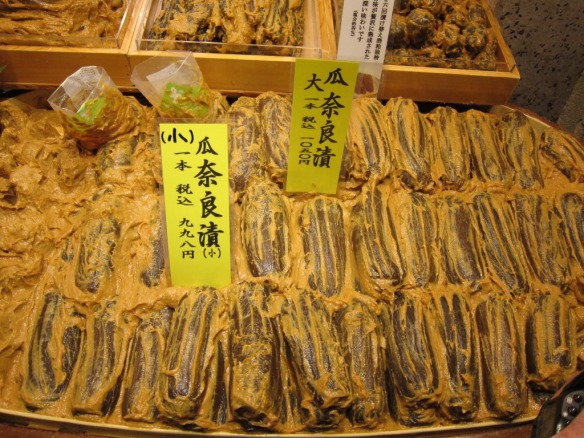I just adore the range of pickled veg I’ve had in Japan. Being a fan of preserving and pickling generally, I really appreciate the care and thought behind even a tiny plate of 2 or 3 varieties presented with a bowl of rice. Pickles are an important part of Japanese cuisine, and particularly of the rice element of a keiseki meal, also. 
They range from the simple, lightly vinegared cucumber slices, as above, and the pink ginger familiar from our sushi trays, the wonderfully sour umeboshi, to elaborate, delicately fragrant varieties and even – to my delight – pickled blossom.
It was no surprise to see an impossibly huge range offered in Japanese markets and food halls. Some were packaged so gorgeously, they must have been intended as gifts. 


The small packs were sooo tempting, but on asking in my terrible, halting Japanese if they would be OK without refrigeration (I’m thinking taking them back home) I was told no, they were lightly pickled and had to be kept chilled. At least, I think that’s what they were saying…Such a shame – I mean look at them! Gorgeous! Pink!
Others, piled high in giant market vats, clearly were for immediate consumption. Well, perhaps not immediate; I guess they probably made it home!
Cucumbers as you’ve never seen them
Chinese cabbage given the pickle once over
Radishes, aubergines and cabbages
I was delighted to see at one stall in Nishiki market that there was both an English explanation and samples, so I could finally put a name to some of the pickles I’d been enjoying the most, including one with a liquorice like texture and, faintly, flavour. Turns out shibatsuke is one of my favourites!
Vegetables pickled in a miso paste – misozuke – were a common theme also. Pickles made at home with miso by the Japanese cook aren’t the vinegared kind as we Westerners know them – they’re often more a blanket or bed of miso in which vegetables are nurtured for a while, then removed and replaced with more vegetables. Some miso pickles take years to mature – you can understand how this would be the perfect way to preserve harvests in days gone by. And so it should be no surprise that this is one of – if not the – oldest form of Japanese pickling. I’m going to have to have a go at these myself.
Miso baby aubergines
This was a wonderland of delightfully fresh (if it’s possible for something preserved to be, at the same time, fresh) pickles of every possible variety. So crunchy they could almost be counted towards your 5 a day. Actually we ate so many during our stay I think they actually were a significant dietary bonus! Practically anything vegetable had been given the preservation treatment, and the range was staggering:
Beautiful daikon
I miss those pickles. I can’t get them here. They simply don’t hold the same niche in the popular psyche anywhere else. There just isn’t the same joy in them in Western countries – just look at the sad jars of vinegary gherkins and onions in our supermarkets. Where’s the subtlety, the enjoyment, appreciation, heck – the fun in that? I agree with the philosophy of the wonderful Sandor Katz, who makes a party out of pickling. Literally. With workshops where you can share the preserving love and – well, pickled vegetables. Where do I sign?










